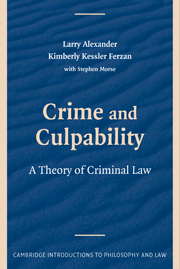Book contents
- Frontmatter
- Contents
- Acknowledgments
- PART ONE Introduction: Retributivism and the Criminal Law
- PART TWO The Culpable Choice
- PART THREE The Culpable Act
- 5 Only Culpability, Not Resulting Harm, Affects Desert
- 6 When Are Inchoate Crimes Culpable and Why?
- 7 The Locus of Culpability
- PART FOUR A Proposed Code
- Epilogue
- Appendix
- Bibliography
- Index
7 - The Locus of Culpability
Published online by Cambridge University Press: 05 June 2012
- Frontmatter
- Contents
- Acknowledgments
- PART ONE Introduction: Retributivism and the Criminal Law
- PART TWO The Culpable Choice
- PART THREE The Culpable Act
- 5 Only Culpability, Not Resulting Harm, Affects Desert
- 6 When Are Inchoate Crimes Culpable and Why?
- 7 The Locus of Culpability
- PART FOUR A Proposed Code
- Epilogue
- Appendix
- Bibliography
- Index
Summary
At this point, we still need an account of what the unit of action is. Given that we deny that the results of an action increase the actor's blameworthiness, and that we believe instead that the sole locus of culpability is an act that unleashes an unjustifiable risk of harm over which the actor no longer has complete control, we should explicate exactly what “a culpable act” is. Because we view crimes as culpable risk creations, what is it exactly that creates that risk? And are failures to act, which cannot create risks themselves, also culpable?
Moreover, we need an account of how to individuate such culpable acts. Having reduced all criminality to risk creation, we need to explain when one risk creation stops and another begins. There are continuous courses of conduct that can be divided – or not – into multiple acts of risk imposition. Take a kidnapping, where the victim is moved over a period of time from A to B, which, as in Achilles and the tortoise, consists of a number of movements approaching infinity over lesser distances. There are also different acts that can occur within one course of conduct. For instance, in a rape case, what determines the number of rapes that have been committed when there are several different forced sexual acts? Then, there are single bodily movements that result in multiple harms. What of an arson during which the actor ignites a building with two people inside?
- Type
- Chapter
- Information
- Crime and CulpabilityA Theory of Criminal Law, pp. 226 - 260Publisher: Cambridge University PressPrint publication year: 2009



